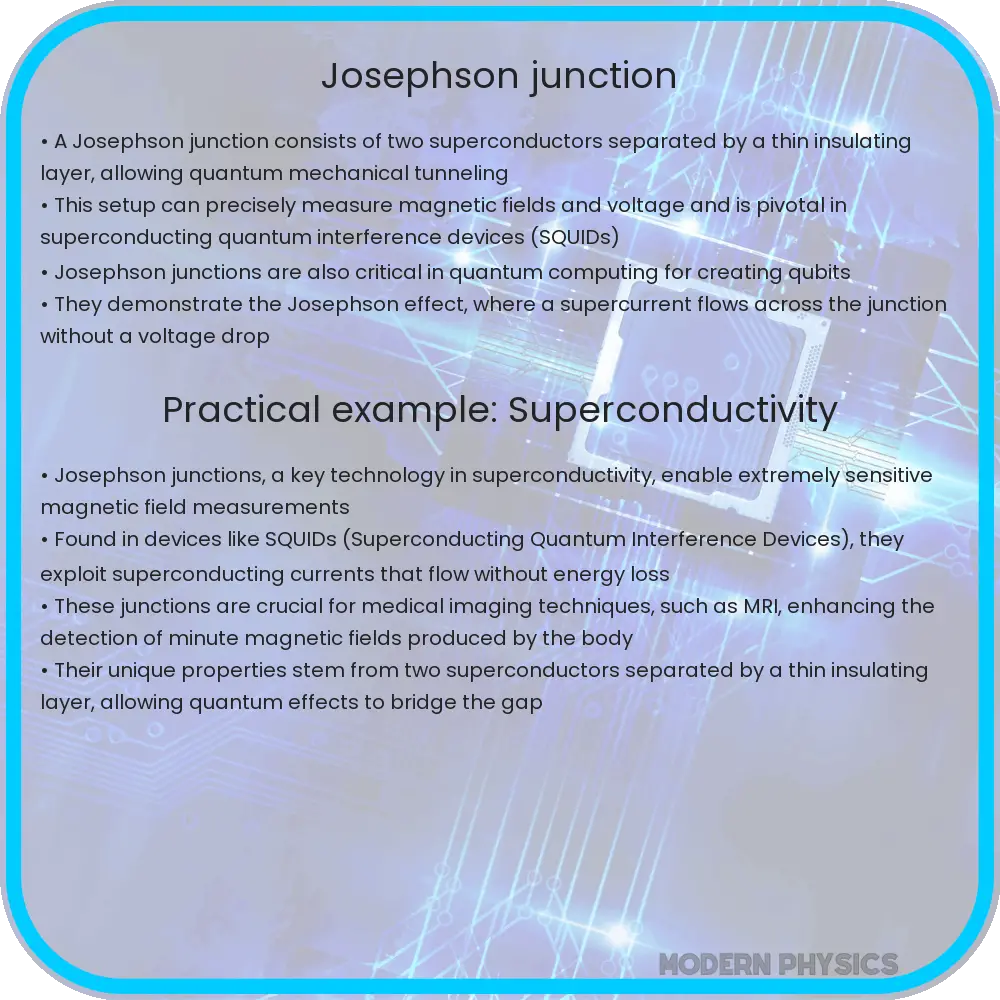Explore the intriguing world of Josephson Junctions, their quantum phenomena, practical applications, and theoretical insights in our detailed article.

Understanding Josephson Junctions: A Gateway to Quantum Phenomena
The Josephson Junction, named after British physicist Brian D. Josephson, who predicted its properties in 1962, stands as a fundamental component in the realm of quantum mechanics and superconductivity. This remarkable device explores the intersection of quantum mechanics and practical applications, offering a window into the mysterious quantum world.
What is a Josephson Junction?
At its core, a Josephson Junction consists of two superconductors separated by a very thin insulating barrier. This configuration allows for the quantum phenomenon known as the Josephson Effect. Superconductors, materials that can conduct electricity without resistance when cooled below a certain temperature, exhibit a unique quantum state. The Josephson Junction leverages this state to create effects that are purely quantum mechanical in nature.
Quantum Phenomena in Josephson Junctions
The most intriguing aspect of a Josephson Junction is the tunneling of Cooper pairs (pairs of electrons bound together at low temperatures) across the insulator. This process, known as Josephson tunneling, leads to the flow of a supercurrent—a current that flows without any voltage across the junction. This phenomenon is described by two key Josephson relations:
- The DC Josephson Effect: A direct current (DC) flows across the junction in the absence of an external voltage, governed by the relation \( I = I_c \sin(\delta) \), where \( I \) is the current, \( I_c \) is the critical current, and \( \delta \) is the phase difference between the superconductors.
- The AC Josephson Effect: An alternating current (AC) flows across the junction under a small voltage, leading to microwave radiation. This is captured by the relation \( V = \frac{\hbar}{2e} \frac{d\delta}{dt} \), where \( V \) is the voltage, \( \hbar \) is the reduced Planck constant, and \( e \) is the electron charge.
Applications of Josephson Junctions
Josephson Junctions have found a wide range of applications, significantly in areas requiring ultra-sensitive measurements. One of the most notable uses is in SQUIDs (Superconducting Quantum Interference Devices), which are among the most sensitive magnetometers, capable of detecting extremely small magnetic fields. This sensitivity has been pivotal in medical imaging techniques like Magnetoencephalography (MEG) and in geological exploration.
Furthermore, Josephson Junctions are integral to the development of quantum computers. They serve as the basis for qubits, the quantum bits that are the building blocks of quantum computing. The unique properties of these junctions, particularly their ability to maintain quantum coherence, make them ideal for creating and manipulating qubits.
Theoretical Foundations of Josephson Junctions
The theoretical underpinnings of Josephson Junctions are deeply rooted in quantum mechanics and the theory of superconductivity. The BCS (Bardeen-Cooper-Schrieffer) theory, which explains the phenomenon of superconductivity, plays a crucial role in understanding these junctions. According to the BCS theory, in superconductors, electrons form Cooper pairs at low temperatures, which move through a lattice without scattering, leading to zero electrical resistance. The Josephson Effects emerge from the coherent tunneling of these Cooper pairs across the insulating barrier, a process explained by quantum mechanics.
Advancements and Future Directions
Research in Josephson Junctions has been continuously evolving, opening new frontiers in both theoretical and applied physics. One area of notable advancement is in the field of topological superconductors, where Josephson Junctions may play a role in understanding and manipulating exotic quantum states. Additionally, in the realm of quantum computing, advancements in Josephson Junction technology are crucial for increasing the stability and scalability of qubits, addressing some of the biggest challenges in the field.
The potential for Josephson Junctions in metrology, particularly in the definition of the volt, has also been a subject of significant interest. The precision offered by the AC Josephson Effect provides an opportunity for more accurate and consistent standards for electrical measurements.
Challenges and Considerations
Despite the promising applications, Josephson Junctions face several challenges. The most significant is the requirement of ultra-low temperatures for superconductivity, which necessitates complex and expensive cooling systems. Additionally, quantum decoherence, a major hurdle in quantum computing, affects the stability of qubits based on Josephson Junctions. Ongoing research is focused on finding materials and designs that can operate at higher temperatures and maintain coherence over longer periods.
Conclusion
Josephson Junctions, embodying the fascinating interplay of quantum mechanics and superconductivity, have paved the way for groundbreaking applications in various fields. From enabling ultra-sensitive measurements in medical and geological instruments to forming the backbone of quantum computing, these junctions demonstrate the profound impact of quantum phenomena in practical technology. As research continues to overcome existing challenges, the future of Josephson Junctions holds immense potential, promising advancements that could redefine the boundaries of technology and our understanding of the quantum world.
